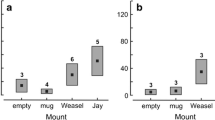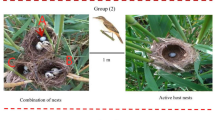Abstract
One hypothesized function of conspicuous mobbing of intruders by bird nest owners is to attract neighbouring birds (“calling for help” hypothesis) or third-party predators (“attract the mightier” hypothesis). These may help the nest owners by distracting and/or attacking the mobbed intruder. To date, these hypotheses have been studied solely during the mobbing of predators. Here, for the first time, I have studied mobbing attraction in the context of brood parasitism. I experimentally tested the Blackcap (Sylvia atricapilla), a small passerine with a highly aggressive and conspicuous nest defence behaviour. I elicited the aggressive responses of Blackcaps by presenting stuffed dummies of the brood parasitic Common Cuckoo (Cuculus canorus) and controls near their nests. At 32% of the nests (n = 75), the responses of the Blackcaps to dummies attracted up to 15 birds per trial from 21 passerine species. Most of the attracted birds were heterospecifics and rarely participated in mobbing; thus the “calling for help” hypothesis was not supported. No potential predators of the Cuckoo were attracted despite them living in the study area and despite prolonged mobbing by Blackcaps; thus rejecting the “attract the mightier” hypothesis. I argue that this hypothesis is unlikely to apply to typical avian predators during nest predation acts because these only last for several seconds. The number of attracted birds was a positive function of the owner’s intensity of nest defence as measured by the rates of alarm calling but not visual cues (rates of attacks). Suitable and unsuitable Cuckoo hosts did not differ in their behaviour in the vicinity of defended nests. The observed pattern of the positive correlation between the intensity of nest defence and the number of attracted birds is most likely a proximate by-product of the conspicuous nest defence by Blackcaps (but may well be adaptive for recruiting neighbours themselves). Thus, the mobbing behaviour of the Blackcap is directed towards the brood parasite and not towards other audience predators or potential recruits to the mob.


Similar content being viewed by others
References
Bourne WRP (1977) The function of mobbing. Br Birds 70:266–267
Brooke M de L, Davies NB, Noble DG (1998) Rapid decline of host defences in response to reduced cuckoo parasitism: behavioural flexibility of reed warblers in a changing world. Proc R Soc Lond B 265:1277–1282
Bures S, Pavel V (2003) Do birds behave in order to avoid disclosing their nest site? Bird Study 50:73–77
Caro T (2005) Antipredator defenses in birds and mammals. University of Chicago Press, Chicago
Curio E (1978) The adaptive significance of avian mobbing I. Teleonomic hypotheses and predictions. Z Tierpsychol 48:175–183
Curio E (1993) Proximate and developmental aspects of antipredator behavior. Adv Stud Behav 22:135–238
Curio E, Klump G, Regelmann K (1983) An anti-predator response in the great tit (Parus major): is it tuned to predator risk? Oecologia 60:83–88
Davies NB, Madden JR, Butchart SHM (2004) Learning fine-tunes a specific response of nestlings to the parental alarm calls of their own species. Proc R Soc Lond B 271:2297–2304
Duckworth JW (1991) Responses of breeding reed warblers Acrocephalus scirpaceus to mounts of sparrowhawk Accipiter nisus, Cuckoo Cuculus canorus and jay Garrulus glandarius. Ibis 133:68–74
Flasskamp A (1994) The adaptive significance of avian mobbing. V. An experimental test of the “move on” hypothesis. Ethology 96:322–333
Ghalambor CK, Martin TE (2001) Fecundity-survival trade-offs and parental risk-taking in birds. Science 292:494–497
Gill SA, Sealy SG (2004) Functional reference in an alarm signal given during nest defence: seet calls of yellow warblers denote brood-parasitic brown-headed cowbirds. Behav Ecol Sociobiol 56:71–80
Gill SA, Grieef PM, Staib LM, Sealy SG (1997) Does nest defence deter or facilitate cowbird parasitism? A test of the nesting-cue hypothesis. Ethology 103:56–71
Grim T (2005a) Host recognition of brood parasites: Implications for methodology in studies of enemy recognition. Auk 122:530–543
Grim T (2005b) Mimicry vs. similarity: which resemblances between brood parasites and their hosts are mimetic and which are not? Biol J Linn Soc 84:69–78
Grim T (2006) Cuckoo growth performance in parasitized and unused hosts: not only host size matters. Behav Ecol Sociobiol 60:716–723
Grim T, Honza M (2001) Differences in behaviour of closely related thrushes (Turdus philomelos and T. merula) to experimental parasitism by the common cuckoo Cuculus canorus. Biologia 56:549–556
Halupka K, Halupka L (1997) The influence of reproductive season stage on nest defence by meadow pipits (Anthus pratensis). Ethol Ecol Evol 9:89–98
Högstedt G (1983) Adaptation unto death: function of fear screams. Am Nat 121:562–570
Honza M, Grim T, Capek M, Moksnes A, Røskaft E (2004a) Nest defence, enemy recognition and nest inspection behaviour of experimentally parasitised reed warblers Acrocephalus scirpaceus. Bird Study 51:256–263
Honza M, Prochazka P, Stokke BG, Moksnes A, Røskaft E, Capek M, Mrlik V (2004b) Are blackcaps current winners in the evolutionary struggle against the common cuckoo? J Ethol 22:175–180
Honza M, Polacikova L, Prochazka P (2007) Ultraviolet and green parts of the colour spectrum affect egg rejection in the song thrush (Turdus philomelos). Biol J Linn Soc 92 (in press)
Hurd CR (1996) Interspecific attraction to the mobbing calls of black-capped chickadees (Parus atricapillus). Behav Ecol Sociobiol 38:287–292
Kamil AC (1988) Experimental design in ornithology. In: Johnston RF (ed) Current ornithology, vol 5. Plenum, New York, pp 313–346
Klump GM, Curio E (1983) Reactions of blue tits Parus caeruleus to hawk models of different sizes. Bird Behav 4:78–81
Krama T, Krams I (2005) Cost of mobbing call to breeding pied flycatcher, Ficedula hypoleuca. Behav Ecol 16:37–40
Krams I, Krama T (2002) Interspecific reciprocity explains mobbing behaviour of the breeding chaffinches, Fringilla coelebs. Proc R Soc Lond B 269:2345–2350
Krams I, Krama T, Igaune K (2006) Mobbing behaviour: reciprocity-based co-operation in breeding pied flycatchers Ficedula hypoleuca. Ibis 148:50–54
Moksnes A, Røskaft E (1992) Responses of some rare cuckoo hosts to mimetic model cuckoo eggs and to foreign conspecific eggs. Ornis Scand 32:17–23
Moksnes A, Røskaft E (1995) Egg-morphs and host preference in the common cuckoo Cuculus canorus: an analysis of cuckoo and host eggs from European museum collections. J Zool 236:625–648
Moksnes A, Røskaft E, Hagen LG, Honza M, Mork C, Olsen PH (2000) Common cuckoo Cuculus canorus and host behaviour at reed warbler Acrocephalus scirpaceus nests. Ibis 142:247–258
Montgomerie RD, Weatherhead PJ (1988) Risks and rewards of nest defence by parent birds. Q Rev Biol 63:167–187
Pavel V, Bures S (2001) Offspring age and nest defence: test of the feedback hypothesis in the meadow pipit. Anim Behav 61:297–303
Payne RB, Payne LL, Rowley I (1985) Splendid wren Malurus splendens response to cuckoos: an experimental test of social organization in a communal bird. Behaviour 94:108–127
Rohwer S, Frettwell SD, Tuckfield RC (1976) Distress screams as a measure of kinship in birds. Am Midl Nat 96:418–430
Røskaft E, Moksnes A, Stokke BG, Bicik V, Moskat C (2002) Aggression to dummy cuckoos by potential European cuckoo hosts. Behaviour 139:613–628
Rothstein SI (2001) Relic behaviours, coevolution and the retention versus loss of host defences after episodes of avian brood parasitism. Anim Behav 61:95–107
Rytkönen S, Soppela M (1995) Vicinity of sparrowhawk nest affects willow tit nest defence. Condor 97:1074–1078
SAS Institute (2004) SAS online doc. SAS Institute, Cary
Schaefer T (2004) Video monitoring of shrub-nests reveals nest predators. Bird Study 51:170–177
Sealy SG, Neudorf DL, Hobson KA, Gill SA (1998) Nest defense by potential hosts of the brown-headed cowbird: methodological approaches, benefits of defence, and coevolution. In: Rothstein SI, Robinson SK (eds) Parasitic birds and their hosts, Oxford University Press, New York, pp 194–211
Sherman PW, Reeve HK, Pfenning DW (1997) Recognition systems. In: Krebs JR, Davies NB (eds) Behavioural ecology, Blackwell, Oxford, pp 69–96
Shirihai H, Gargallo G, Helbig AJ (2001) Sylvia warblers. Princeton University Press, Princeton
Smith S, Hosking E (1955) Birds fighting. Experimental studies of the aggressive displays of some birds. Faber and Faber, London
Soler M, Martin-Vivaldi M, Perez-Contreras T (2002) Identification of the sex responsible for recognition and the method of ejection of parasitic eggs in some potential common cuckoo hosts. Ethology 108:1093–1101
Veen T, Richardson DS, Blaakmeer K, Komdeur J (2000) Experimental evidence for innate predator recognition in the Seychelles warbler. Proc R Soc Lond B 267:2253–2258
Winkler DW (1994) Antipredator defense by neighbors as a responsive amplifier of parental defense in tree swallows. Anim Behav 47:595–605
Wyllie I (1975) Study of cuckoos and reed warblers. Br Birds 68:369–378
Yasukawa K (1989) The costs and benefits of a vocal signal: the nest-associated ‘chit’ of the female red-winged blackbirds, Agelaius phoeniceus. Anim Behav 38:866–874
Yom-Tov Y (2001) An updated list and some comments on the occurrence of intraspecific nest parasitism in birds. Ibis 143:133–143
Acknowledgments
I thank two anonymous referees, S. A. Gill, M. E. Hauber, I. Krams, V. Pavel, and V. Remeš for comments on the draft. I am especially grateful to E. Curio for his extensive and insightful comments and to V. Pavel for helping me with the literature. I am indebted to M. Čapek for providing breeding density data and to D. Campbell for correcting the language. I was supported by grants MSM6198959212 and GACR 206/03/D234.
Author information
Authors and Affiliations
Corresponding author
Additional information
Communicated by T. Friedl.
Rights and permissions
About this article
Cite this article
Grim, T. Are Blackcaps (Sylvia atricapilla) defending their nests also calling for help from their neighbours?. J Ornithol 149, 169–180 (2008). https://doi.org/10.1007/s10336-007-0257-7
Received:
Revised:
Accepted:
Published:
Issue Date:
DOI: https://doi.org/10.1007/s10336-007-0257-7




